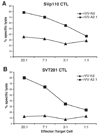An SV40 VP1-derived epitope recognized by CD8+ T cells is naturally processed and presented by HLA-A*0201 and cross-reactive with human polyomavirus determinants
- PMID: 18402997
- PMCID: PMC2464359
- DOI: 10.1016/j.virol.2008.02.033
An SV40 VP1-derived epitope recognized by CD8+ T cells is naturally processed and presented by HLA-A*0201 and cross-reactive with human polyomavirus determinants
Abstract
The CD8+ T cell responses directed toward the VP1 antigens of human polyomaviruses JC and BK recently were shown to be cross-reactive. Two HLA-A0201-restricted determinants from each virus have been defined and include JCp100-108 (ILMWEAVTL) and BKp108-116 (LLMWEAVTV) as well as JCp36-44 (SITEVECFL) and BKp44-52 (AITEVECFL). We asked whether VP1 from the related SV40 contains similar HLA-A0201-restricted determinants. In this study, we demonstrate that CD8+ T cells specific for SV40 VP1 p110-118 (ILMWEAVTV), but not p46-54 (SFTEVECFL), can be induced in HLA-A0201-transgenic mice and that these CD8+ T cells cross-react with the corresponding determinants from JC and BK virus. The SV40 p110 determinant was found to be processed and presented in SV40-infected cells. These results indicate that the JCp36/BKp44 determinants are distinctive for the human polyomaviruses while the JCp100/BKp108/SVp110 determinants are shared by all three viruses, providing a target for CD8+ T cell cross-reactivity.
Figures





References
-
- Antinori A, Ammassari A, Giancola ML, Cingolani A, Grisetti S, Murri R, Alba L, Ciancio B, Soldani F, Larussa D, Ippolito G, De Luca A. Epidemiology and prognosis of AIDS-associated progressive multifocal leukoencephalopathy in the HAART era. J Neurovirol. 2001;7(4):323–328. - PubMed
-
- Arthur RR, Shah KV, Baust SJ, Santos GW, Saral R. Association of BK viruria with hemorrhagic cystitis in recipients of bone marrow transplants. N Engl J Med. 1986;315(4):230–234. - PubMed
-
- Bacik I, Cox JH, Anderson R, Yewdell JW, Bennink JR. TAP (transporter associated with antigen processing)-independent presentation of endogenously synthesized peptides is enhanced by endoplasmic reticulum insertion sequences located at the amino- but not carboxyl-terminus of the peptide. J Immunol. 1994;152(2):381–387. - PubMed
-
- Bedi A, Miller CB, Hanson JL, Goodman S, Ambinder RF, Charache P, Arthur RR, Jones RJ. Association of BK virus with failure of prophylaxis against hemorrhagic cystitis following bone marrow transplantation. J Clin Oncol. 1995;13(5):1103–1109. - PubMed
-
- Bonneau RH, Salvucci LA, Johnson DC, Tevethia SS. Epitope specificity of H-2Kb-restricted, HSV-1-, and HSV-2-cross-reactive cytotoxic T lymphocyte clones. Virology. 1993;195(1):62–70. - PubMed
Publication types
MeSH terms
Substances
Grants and funding
LinkOut - more resources
Full Text Sources
Other Literature Sources
Molecular Biology Databases
Research Materials

